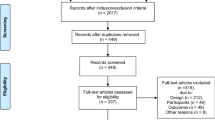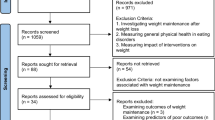Abstract
Purpose
Cachexia is a wasting condition affecting approximately 50% of cancer patients, associated with decreased quality of life and survival. Barwon Health’s Cachexia and Nutrition Support Service provides person-centred interdisciplinary care to assist the management of cachexia symptoms. This study describes a novel and effective service model established in a regional cachexia clinic and the patient population it serves.
Methods
A descriptive, retrospective longitudinal study was conducted of records from patients attending Barwon Health between 2008 and 2013 (n = 175), alongside the description of service refinement over this time. Patients with ≥ 2 attendance dates were assessed for anthropometric measures, follow-up intervals, and muscle function outcomes to describe patient trajectory during clinic involvement.
Results
This is the first detailed description of a successful interdisciplinary clinic specific to cancer cachexia management, where patients are seen outside established 8- to 12-week structured programs which prevail in other cachexia clinics. Seventy-five patients (43%) attended one appointment only, with almost half of these (n = 33) first attending within 60 days of death. Of the 99 patients with two or more appointments, 49% displayed positive outcomes with > 2-kg weight gain between two consecutive appointments, and > 50% improved functional strength between two consecutive appointments.
Conclusions
The majority of patients attending clinic multiple times maintained or increased weight and functional status during their involvement with the service. However, successes of care provision were muted by high attrition, primarily due to delayed referral and expected high mortality within the study cohort. Planned future analyses with greater patient numbers and cancer stratification will establish cachectic populations most likely to benefit from this novel mode of interdisciplinary care. The Cachexia and Nutrition Support Service provides an effective and efficient service model for the provision of specialist cachexia care to community-dwelling patients in regional Australia.



Similar content being viewed by others
Data availability
The authors have full control of primary data and agree to allow the journal to review data if requested.
References
Fearon K, Strasser F, Anker SD, Bosaeus I, Bruera E, Fainsinger RL, Jatoi A, Loprinzi C, MacDonald N, Mantovani G, Davis M, Muscaritoli M, Ottery F, Radbruch L, Ravasco P, Walsh D, Wilcock A, Kaasa S, Baracos VE (2011) Definition and classification of cancer cachexia: an international consensus. Lancet Oncol 12:489–495. https://doi.org/10.1016/S1470-2045(10)70218-7
Del Fabbro E, Orr TA, Stella SM (2017) Practical approaches to managing cancer patients with weight loss. Curr Opin Support Palliat Care 11:272–277. https://doi.org/10.1097/SPC.0000000000000300
Hopkinson JB, Wright DNM, McDonald JW, Corner JL (2006) The prevalence of concern about weight loss and change in eating habits in people with advanced cancer. J Pain Symptom Manag 32:322–331. https://doi.org/10.1016/j.jpainsymman.2006.05.012
Fearon KCH (2008) Cancer cachexia: developing multimodal therapy for a multidimensional problem. Eur J Cancer 44:1124–1132. https://doi.org/10.1016/j.ejca.2008.02.033
Chasen M, Bhargava R, MacDonald N (2014) Rehabilitation for patients with advanced cancer. CMAJ 186:1071–1075. https://doi.org/10.1503/cmaj.131402
M R Chasen APD (2008) Cancer nutrition and rehabilitation—its time has come! Curr Oncol 15:117–122. https://doi.org/10.3747/co.v15i3.244
MacDonald N (2007) Cancer cachexia and targeting chronic inflammation: a unified approach to cancer treatment and palliative/supportive care. J Support Oncol 5:157–162
Glare P, Jongs W, Zafiropoulos B (2011) Establishing a cancer nutrition rehabilitation program (CNRP) for ambulatory patients attending an Australian cancer center. Support Care Cancer 19:445–454. https://doi.org/10.1007/s00520-010-0834-9
Granda-Cameron C, DeMille D, Lynch MP, Huntzinger C, Alcorn T, Levicoff J, Roop C, Mintzer D (2010) An interdisciplinary approach to manage cancer cachexia. Clin J Oncol Nurs 14:72–80. https://doi.org/10.1188/10.CJON.72-80
Watkins F, Tulloch S, Bennett C, Webster B, McCarthy C (2012) A multimodal, interdisciplinary programme for the management of cachexia and fatigue. Int J Palliat Nurs 18:85–90. https://doi.org/10.12968/ijpn.2012.18.2.85
Wilcock A (2012) Final report: Nottingham Macmillan Lung Cancer CARE service. Nottingham University Hospitals NHS Trust
Chasen MR, Feldstain A, Gravelle D, MacDonald N, Pereira J (2013) An interprofessional palliative care oncology rehabilitation program: effects on function and predictors of program completion. Curr Oncol 20:301. https://doi.org/10.3747/co.20.1607
Parmar MP, Swanson T, Jagoe RT (2013) Weight changes correlate with alterations in subjective physical function in advanced cancer patients referred to a specialized nutrition and rehabilitation team. Support Care Cancer 21:2049–2057. https://doi.org/10.1007/s00520-013-1762-2
Vaughan V, Farrell H, Martin P, Lewandowski PA (2013) Abstract 3-13; characterisation of a patient population presenting to an interdisciplinary cancer cachexia clinic in regional Victoria, Australia. J Cachexia Sarcopenia Muscle 4:321–322. https://doi.org/10.1007/s13539-013-0123-9
Bachmann J, Heiligensetzer M, Krakowski-Roosen H, Büchler MW, Friess H, Martignoni ME (2008) Cachexia worsens prognosis in patients with resectable pancreatic cancer. J Gastrointest Surg 12:1193–1201. https://doi.org/10.1007/s11605-008-0505-z
Morley JE, Thomas DR, Wilson M-MG (2006) Cachexia: pathophysiology and clinical relevance. Am J Clin Nutr 83:735–743
Martin LL, Watanabe S, Fainsinger R, Lau F, Ghosh S, Quan H, Atkins M, Fassbender K, Downing GM, Baracos V (2010) Prognostic factors in patients with advanced cancer: use of the patient-generated subjective global assessment in survival prediction. J Clin Oncol 28:4376–4383. https://doi.org/10.1200/JCO.2009.27.1916
Maggiore RJ, Gross CP, Hurria A (2010) Polypharmacy in older adults with cancer. Oncologist 15:507–522. https://doi.org/10.1634/theoncologist.2009-0290
Jones CJ, Rikli RE, Beam WC (1999) A 30-s chair-stand test as a measure of lower body strength in community-residing older adults. Res Q Exerc Sport 70:113–119. https://doi.org/10.1080/02701367.1999.10608028
Bohannon RW, Magasi SR, Bubela DJ, Wang YC, Gershon RC (2012) Grip and knee extension muscle strength reflect a common construct among adults. Muscle Nerve 46:555–558. https://doi.org/10.1002/mus.23350
Norman K, Stobäus N, Smoliner C, Zocher D, Scheufele R, Valentini L, Lochs H, Pirlich M (2010) Clinical Nutrition. Clin Nutr 29:586–591. https://doi.org/10.1016/j.clnu.2010.02.007
Flood A, Chung A, Parker H, Kearns V, O’Sullivan TA (2013) The use of hand grip strength as a predictor of nutrition status in hospital patients. Clin Nutr 33:1–9. https://doi.org/10.1016/j.clnu.2013.03.003
Ripamonti C, Zecca E, Brunelli C, Fulfaro F, Villa S, Balzarini A, Bombardieri E, Conno FD (1998) A randomized, controlled clinical trial to evaluate the effects of zinc sulfate on cancer patients with taste alterations caused by head and neck irradiation. Cancer 82:1938–1945. https://doi.org/10.1002/(sici)1097-0142(19980515)82:10<1938::aid-cncr18>3.0.co;2-u
Siren PMA, Siren MJ (2010) Systemic zinc redistribution and dyshomeostasis in cancer cachexia. J Cachexia Sarcopenia Muscle 1:23–33. https://doi.org/10.1007/s13539-010-0009-z
Murphy RA, Yeung E, Mazurak VC, Mourtzakis M (2011) Influence of eicosapentaenoic acid supplementation on lean body mass in cancer cachexia. Br J Cancer 105:1469–1473. https://doi.org/10.1038/bjc.2011.391
Hopkinson JB, Corner JL (2006) Helping patients with advanced cancer live with concerns about eating: a challenge for palliative care professionals. J Pain Symptom Manag 31:293–305. https://doi.org/10.1016/j.jpainsymman.2005.09.005
Hopkinson JB (2014) Psychosocial impact of cancer cachexia. J Cachexia Sarcopenia Muscle 5:89–94. https://doi.org/10.1007/s13539-014-0142-1
Reuben DB, Moore AA, Damesyn M, Keeler E, Harrison GG, Greendale GA (1997) Correlates of hypoalbuminemia in community-dwelling older persons. Am J Clin Nutr 66:38–45. https://doi.org/10.1093/ajcn/66.1.38
Temel JS, Abernethy AP, Currow DC, Friend J, Duus EM, Yan Y, Fearon KC (2016) Anamorelin in patients with non-small-cell lung cancer and cachexia (ROMANA 1 and ROMANA 2): results from two randomised, double-blind, phase 3 trials. Lancet Oncol 17:519–531. https://doi.org/10.1016/S1470-2045(15)00558-6
Australian Department of Health. Pharmaceutical Benefits Scheme - Testosterone. Available from: http://www.pbs.gov.au/medicine/item/8098F-8099G-8460G-8619P-8830R. Accessed February 8, 2019
Blauwhoff-Buskermolen S, Langius JAE, Becker A, Verheul HMW, de van der Schueren MAE (2017) The influence of different muscle mass measurements on the diagnosis of cancer cachexia. J Cachexia Sarcopenia Muscle 8:615–622. https://doi.org/10.1002/jcsm.12200
Dewys WD, Begg C, Lavin PT, Band PR, Bennett JM, Bertino JR, Cohen MH, Douglass HO Jr, Engstrom PF, Ezdinli EZ, Horton J, Johnson GJ, Moertel CG, Oken MM, Perlia C, Rosenbaum C, Silverstein MN, Skeel RT, Sponzo RW, Tormey DC (1980) Prognostic effect of weight loss prior to chemotherapy in cancer patients. Am J Med 69:491–497. https://doi.org/10.1016/S0149-2918(05)80001-3
Fritschi L, Driscoll T (2006) Cancer due to occupation in Australia. Aust NZ J Publ Heal 30:213–219. https://doi.org/10.1111/j.1467-842X.2006.tb00860.x
Baracos VE, Reiman TJ, Mourtzakis M, Gioulbasanis I, Antoun S (2010) Body composition in patients with non-small cell lung cancer: a contemporary view of cancer cachexia with the use of computed tomography image analysis. Am J Clin Nutr 91:1133S–1137S. https://doi.org/10.3945/ajcn.2010.28608C
Cosper PF, Leinwand LA (2011) Cancer causes cardiac atrophy and autophagy in a sexually dimorphic manner. Cancer Res 71:1710–1720. https://doi.org/10.1158/0008-5472.CAN-10-3145
Tuca A, Jimenez-Fonseca P, Gascón P (2013) Clinical evaluation and optimal management of cancer cachexia. CRC Cr Rev Oncol-Hem 88:625–636. https://doi.org/10.1016/j.critrevonc.2013.07.015
Argilés JM, Meijsing SH, Pallares-Trujillo J et al (2001) Cancer cachexia: a therapeutic approach. Med Res Rev 21:83–101. https://doi.org/10.1002/1098-1128(200101)21:1<83::aid-med4>3.0.co;2-1
Illman J, Corringham R, Robinson D et al (2005) Are inflammatory cytokines the common link between cancer-associated cachexia and depression? J Support Oncol 3:37–50
Chochinov HM (2001) Depression in cancer patients. Lancet Oncol 2:499–505. https://doi.org/10.1016/S1470-2045(01)00456-9
Raison CL, Miller AH (2003) Depression in cancer: new developments regarding diagnosis and treatment. Biol Psychiatry 54:283–294. https://doi.org/10.1016/S0006-3223(03)00413-X
Prado CM, Baracos VE, McCargar LJ et al (2007) Body composition as an independent determinant of 5-fluorouracil-based chemotherapy toxicity. Clin Cancer Res 13:3264–3268. https://doi.org/10.1158/1078-0432.CCR-06-3067
Prado CM, Baracos VE, McCargar LJ et al (2009) Sarcopenia as a determinant of chemotherapy toxicity and time to tumor progression in metastatic breast cancer patients receiving capecitabine treatment. Clin Cancer Res 15:2920–2926. https://doi.org/10.1158/1078-0432.CCR-08-2242
Andreyev HJ, Norman AR, Oates J, Cunningham D (1998) Why do patients with weight loss have a worse outcome when undergoing chemotherapy for gastrointestinal malignancies? Eur J Cancer 34:503–509. https://doi.org/10.1016/s0959-8049(97)10090-9
Groenvold M, Petersen MA, Aaronson NK, Arraras JI, Blazeby JM, Bottomley A, Fayers PM, de Graeff A, Hammerlid E, Kaasa S, Sprangers MAG, Bjorner JB (2006) The development of the EORTC QLQ-C15-PAL: a shortened questionnaire for cancer patients in palliative care. Eur J Cancer 42:55–64. https://doi.org/10.1016/j.ejca.2005.06.022
Ribaudo JM, Cella D, Hahn EA et al (2001) Re-validation and shortening of the Functional Assessment of Anorexia/Cachexia Therapy (FAACT) questionnaire. Qual Life Res 9:1137–1146
Acknowledgements
The authors wish to acknowledge the staff and patients of the Barwon Health Cachexia and Nutrition Support Service.
Funding
Dr. Vaughan received Ph.D. stipend support during the study from the Victorian Cancer Agency, funded by the State Government of Victoria Australia (grant number SCS0904), Bellberry Ltd. (Deakin University School of Medicine Bellberry Support Scholarship), and Deakin University (Faculty of Health HDR Publication Award). The funding bodies were not involved in study design, collection, analysis and interpretation of data, the writing of the manuscript, or the decision to submit the article for publication.
Author information
Authors and Affiliations
Corresponding author
Ethics declarations
Ethical approval
All procedures performed in studies involving human participants were in accordance with the ethical standards of the Barwon Health Human Research Ethics Committee (application number 13/150) and with the 1964 Helsinki declaration and its later amendments or comparable ethical standards.
Conflict of interest
The authors declare that they have no conflict of interest.
Additional information
Publisher’s note
Springer Nature remains neutral with regard to jurisdictional claims in published maps and institutional affiliations.
Rights and permissions
About this article
Cite this article
Vaughan, V.C., Farrell, H., Lewandowski, P.A. et al. Defining a new model of interdisciplinary cancer cachexia care in regional Victoria, Australia. Support Care Cancer 28, 3041–3049 (2020). https://doi.org/10.1007/s00520-019-05072-w
Received:
Accepted:
Published:
Issue Date:
DOI: https://doi.org/10.1007/s00520-019-05072-w




